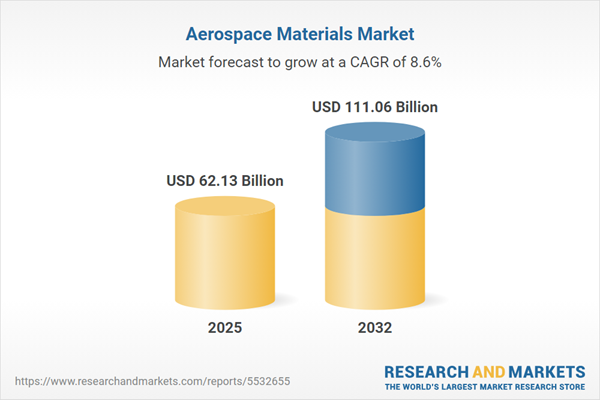Speak directly to the analyst to clarify any post sales queries you may have.
The aerospace materials market is evolving as industry leaders respond to shifting regulatory priorities, technological breakthroughs, and new demands for sustainability. Advancements in composites, alloys, and digital manufacturing are prompting organizations to rethink R&D, procurement, and supply chain strategies—positioning the sector for a new era of innovation.
Market Snapshot: Aerospace Materials Market Growth and Opportunities
The Aerospace Materials Market grew from USD 57.22 billion in 2024 to USD 62.13 billion in 2025, with further projected expansion at a CAGR of 8.64% to USD 111.06 billion by 2032. This growth reflects robust demand for novel lightweight materials, ongoing technological adoption, and heightened emphasis on complying with sustainability and regulatory benchmarks. As significant players adjust strategies to capture value in a dynamic market, emerging manufacturing techniques and supply chain developments continue to reshape the competitive landscape.
Scope & Segmentation
This report delivers in-depth analysis of the aerospace materials landscape, spanning granular market segmentation, technological trends, and regional developments that are essential for senior executives.
- Material Types: Ceramics (Oxide Ceramics, Non-Oxide Ceramics), Composites (Aramid Fiber, Carbon Fiber, Ceramic Matrix, Glass Fiber), Metals (Aluminum Alloys, Nickel Alloys, Titanium Alloys), Polymers (Elastomers, Thermoplastics, Thermosets)
- Application Areas: Airframe Structures (Empennage, Fuselage, Landing Gear, Wings), Avionics (Circuit Boards, Connectors, Housings), Engines (Casings, Discs, Turbine Blades), Interior Components (Cabin Panels, Flooring, Seating)
- Manufacturing Processes: Additive Manufacturing (Directed Energy Deposition, Fused Deposition Modeling, Powder Bed), Casting (Die Casting, Investment Casting, Sand Casting), Forming (Extrusion, Forging, Rolling), Joining (Adhesive Bonding, Brazing, Welding), Machining (Drilling, Milling, Turning)
- End Uses: Commercial Aviation, Defense Aviation, General Aviation, Space Exploration
- Distribution Channels: Aftermarket (MRO Facilities, Spare Parts Dealers), OEM (Tier 1, Tier 2, Tier 3)
- Regions Covered: Americas (North America—including United States, Canada, Mexico—and Latin America such as Brazil and Argentina), Europe, Middle East & Africa (United Kingdom, Germany, France, UAE, South Africa), Asia-Pacific (China, India, Japan, Australia, South Korea, Indonesia, among others)
- Companies Analyzed: Hexcel Corporation, Toray Industries, Inc., Solvay SA, Teijin Limited, SGL Carbon SE, Mitsubishi Chemical Holdings Corporation, Gurit Holding AG, Koninklijke Ten Cate N.V., Owens Corning, PPG Industries, Inc.
Key Takeaways for Aerospace Material Decision-Makers
- High-performance composites and additive manufacturing are redefining production, resulting in lighter aircraft and improved operational efficiency.
- Regulatory scrutiny is increasing, pushing for lower lifecycle emissions and integration of sustainable, recyclable, and bio-based polymers across new aircraft models.
- Legacy supply chains are experiencing transformation with the rise of strategic partnerships and investments in digital twins and predictive analytics for enhanced quality and risk mitigation.
- Regional diversification is shaping supply strategies, with North American and European hubs driving MRO investments and Middle Eastern and Asia-Pacific regions emphasizing local capabilities and industrial partnerships.
- Collaboration among material scientists, manufacturers, and regulatory authorities is now critical to accelerate innovation cycles and remain competitive.
Tariff Impact: Navigating Cost Structures and Global Procurement
The introduction of new United States tariffs in 2025 has increased complexity in global supply chains. Higher duties on steel, aluminum, and specialty alloys have led manufacturers to re-examine supplier networks, prioritize domestic sourcing, and invest in local production for critical aerospace inputs. While procurement leaders are adapting with advanced financial strategies and digital tracking tools, these shifts emphasize the need for resilient and regionally diversified supply chains capable of mitigating cost volatility.
Methodology & Data Sources
This report applies a hybrid research methodology, integrating qualitative insights from industry experts with in-depth quantitative analysis. Primary interviews and case studies are triangulated with technical literature, patent data, and trade sources to deliver a comprehensive, data-driven view of the aerospace materials market. Advanced modeling and scenario analysis further enhance forecast accuracy.
Why This Report Matters for Senior Executives
- Enables strategic planning by presenting clear insights on market shifts, regulatory drivers, and technology trends that directly impact supply chain and R&D decisions.
- Identifies actionable pathways to enhance operational resilience, unlock partnership value, and harness emerging materials and manufacturing innovations.
- Guides resource allocation and investment prioritization to secure competitive advantage in rapidly evolving regional and global markets.
Conclusion
The aerospace materials industry is advancing rapidly through new technologies, increased regulatory focus, and greater sustainability pressures. Executives equipped with thorough analysis are best positioned to innovate, adapt procurement strategies, and lead in this transforming environment.
Additional Product Information:
- Purchase of this report includes 1 year online access with quarterly updates.
- This report can be updated on request. Please contact our Customer Experience team using the Ask a Question widget on our website.
Table of Contents
3. Executive Summary
4. Market Overview
7. Cumulative Impact of Artificial Intelligence 2025
Companies Mentioned
The companies profiled in this Aerospace Materials market report include:- Hexcel Corporation
- Toray Industries, Inc.
- Solvay SA
- Teijin Limited
- SGL Carbon SE
- Mitsubishi Chemical Holdings Corporation
- Gurit Holding AG
- Koninklijke Ten Cate N.V.
- Owens Corning
- PPG Industries, Inc.
Table Information
| Report Attribute | Details |
|---|---|
| No. of Pages | 190 |
| Published | October 2025 |
| Forecast Period | 2025 - 2032 |
| Estimated Market Value ( USD | $ 62.13 Billion |
| Forecasted Market Value ( USD | $ 111.06 Billion |
| Compound Annual Growth Rate | 8.6% |
| Regions Covered | Global |
| No. of Companies Mentioned | 11 |









